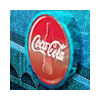Summary
Coke Studios was a branded virtual world targeted to teens globally. Users created their avatar through a choice of looks and styles. On entry, denizens were granted their own set of studios to create and spin their own custom mixes. An economy centered around the accumulation of "decibels" earned by favorable DJ mix reviews as well as virtual Coke consumption. Decibels were spent to populate your pad with "furni" - furniture and other items. At its' height, Coke Studios had over 1 million page views a day with average growth of over 200,000 unique visitors per month, and average visits lasting longer than 25 minutes. It was the 3rd most popular teen website in 2004.
My roles included: client-side development of the moderator tool, the administrator tool, UI code, Shark Tales and American Idol public studios and associated promotional furni. The project consisted of a Shockwave/Flash client wrapped around a Java server-side structure connected to 3 databases and a game server.

Coke Studios Portal
This was the point of entry to the virtual world. Public and Private Studios are displayed on the tabbed popup dialog for users to select their choice of location. Public Studios were named after locations around the world. Private Studios were named by their owner. A user could see the amount of people occupying a studio at any time.

Public Studio: London
Avatars (AKA V-Egos) are lined up to play their stored mixes to a global audience within this virtual club. Bold, italicized chat text identifies the speaker is on stage. On the Tool Bar there is a highlighted messaging icon. The user has received a private text message. Each user had an ample amount of messaging space in the database.

Public Studio: Alaska
V-Egos display their feelings about the music via on-line votes. Receiving positive votes ("green") gains the user more monetary units - decibels. All of the votes and decibels are elements of persistent data stored in a game database. LeBrON_ThUg is too far away from the user's V-Ego to be heard clearly, thus the .art..ly .xpos.d t.xt.
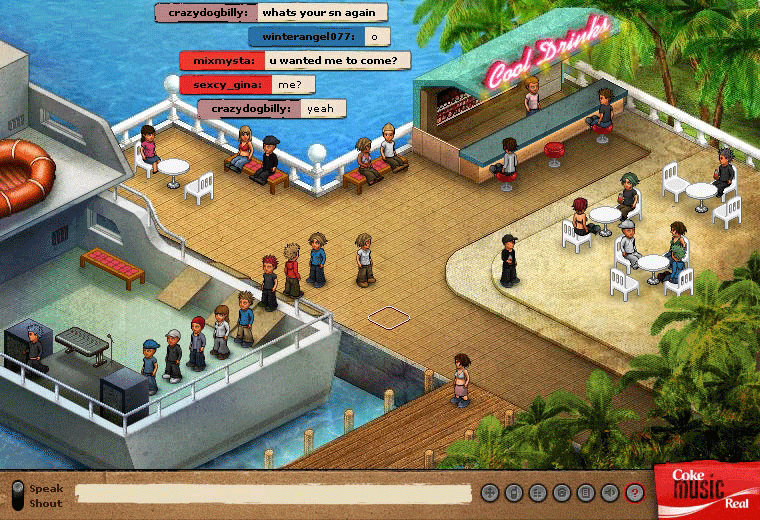
Public Studio: Miami
In the upper right, you can see a slight drawing error where the back of one of the white deck chairs is appearing BEHIND the female V-Ego's seated body. One of my many tasks was to find and fix these errors. The rendering layers were determined by a series of algorithms based on the isometric grid and the object's spatial characteristics.
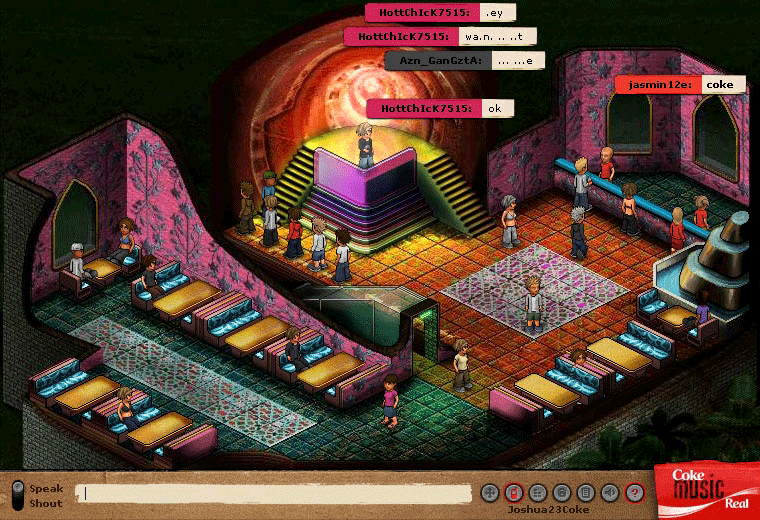
Public Studio: Goa
V-Egos would be jettisoned into a studio via an entrance (note the greenish glass stairwell) plus a few tiles of default walking space. Similar blocking techniques were used for the DJ queues and to keep V-Egos from walking through each other and solid objects...er...like the booth in the lower right.
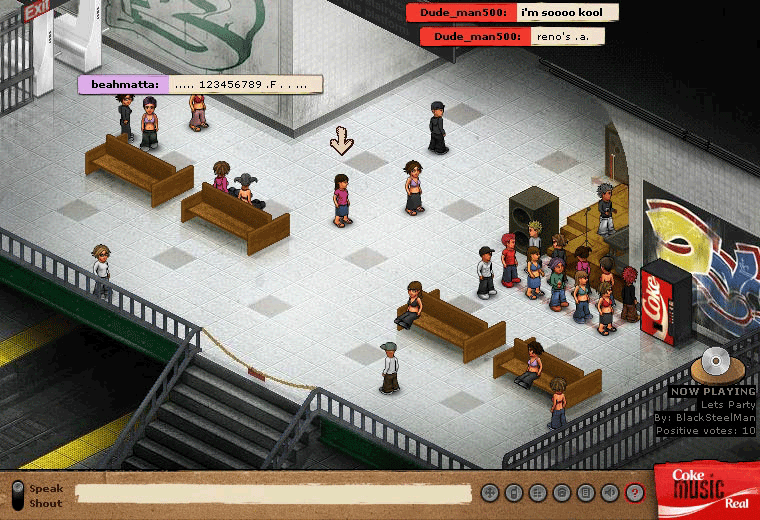
Public Studio: New York
The A* algorithm was translated to client-side ActionScript code to determine avatar pathfinding heuristics. V-Ego states were communicated to client and server regularly via Flash Remoting RPC. Flash worked as a smooth layer between Director and Java.
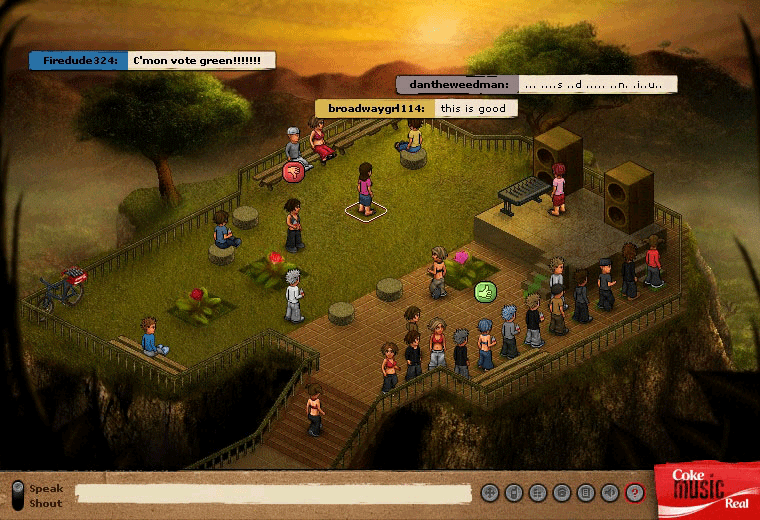
Public Studio: Mombasa
The Studiocom designers were able to exude rich, tactile 24-bit landscapes that freed the V-Egos from their limited indexed 8-bit color palette. In a scene like this, we would render upwards of 800 sprite channels using imaging Lingo. Fortunately, the Shockwave player was able to handle the overhead.
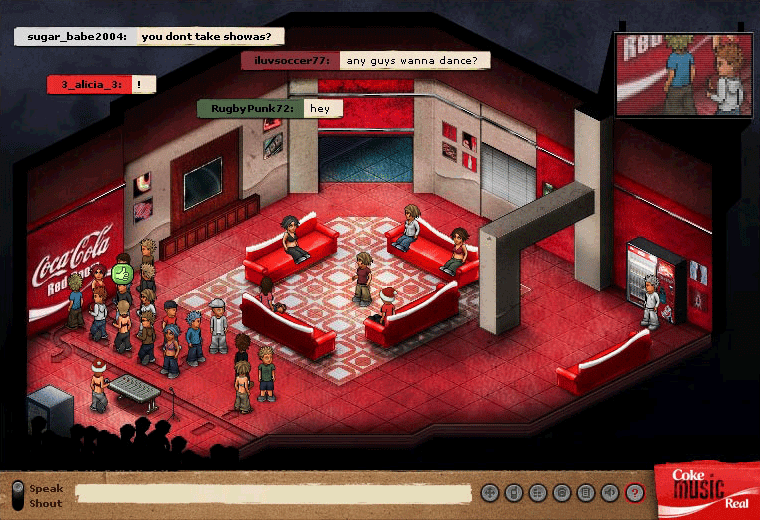
Public Studio: Coke Red Room
A "live" video feed was achieved via imaging Lingo scaling and compositing techniques. Chat boxes are color-coded to match V-Ego clothing. The chat boxes would scroll vertically over time. Bold text denotes that sugar_babe2004 is "shouting" out to the other V-Egos.

Public Studio: Moscow
Bot bartender, Stanislav (red t-shirt and bald head), is offering free virtual Cokes to passers-by. I developed a bot chat engine that used an XML source so that Coca-Cola marketing scribes could participate in the creation. Coca-Cola also tracked detailed game behavior such as Cokes consumed, mixes created, and purchases made.
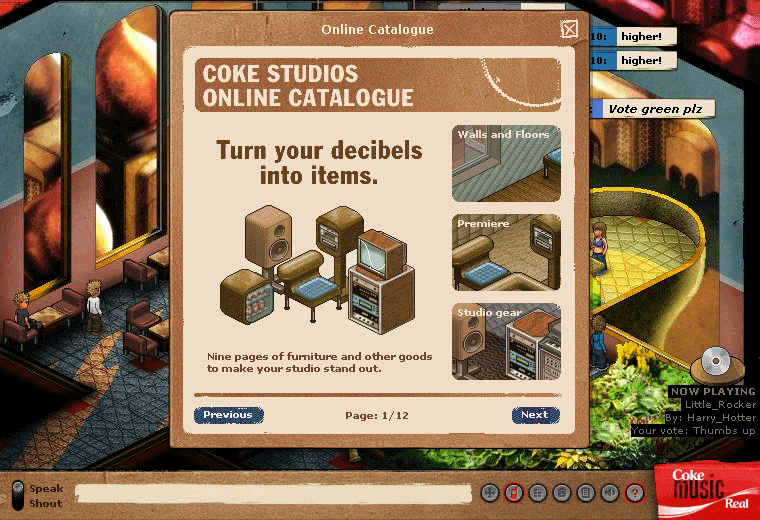
Public Studio: Moscow
I developed the GUI code to display windows such as this popup catalog dialog. The window manager used 9-sliced graphics, imaging Lingo, and an OOP structure externalized via XML markup to help manage changes easily.
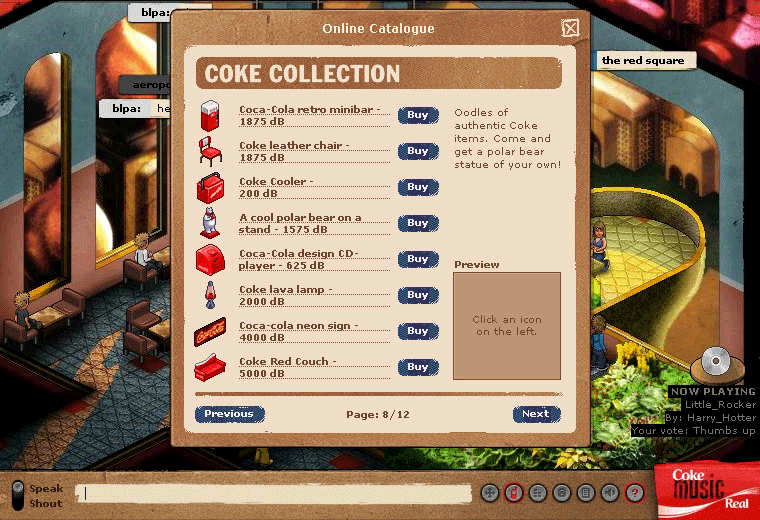
Public Studio: Moscow
The catalog was database-driven, making maintenance easier. This relational database stored inventory and items purchased as well as V-Ego possessions. Database connectivity proved challenging when the game was scaled from development to a production environment hosting 5,000 concurrent users over a distributed server network.
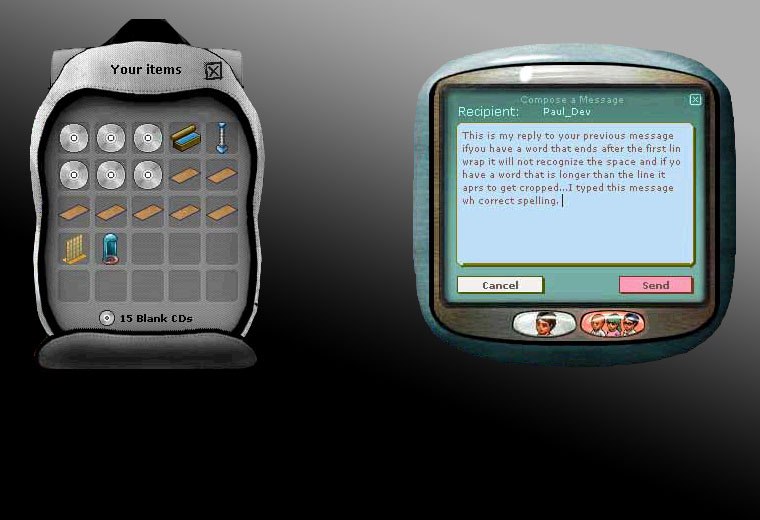
Custom Popup Dialogs
A backpack stored each denizen's possessions and displayed them for inventory browsing. CDs are used to store the user's mixes for playback in any public or private studio. The text messaging screen presented some issues in early testing (a Director bug that I tracked down and created a workaround for).
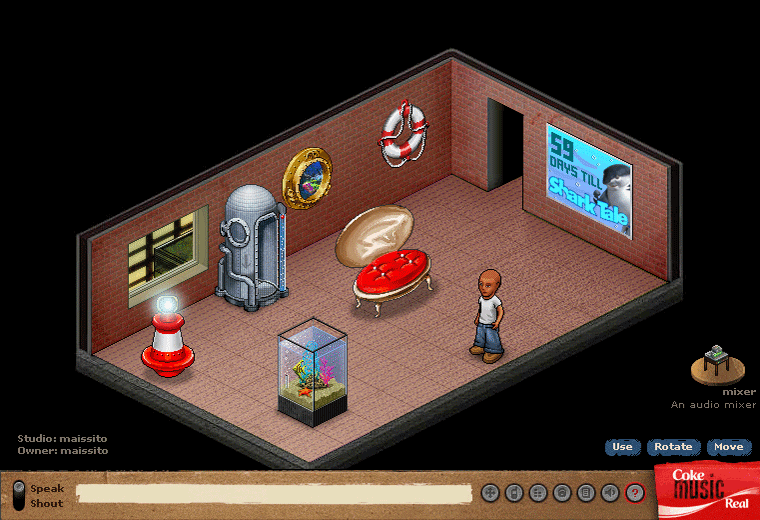
Private Studio: maissito
New furni would be thoroughly tested within our development environment before release into production. I worked on these pieces designed for a co-branding campaign with Shark Tales. I also developed an underwater Public Studio and V-Egos with octopus tentacles for legs for this project.
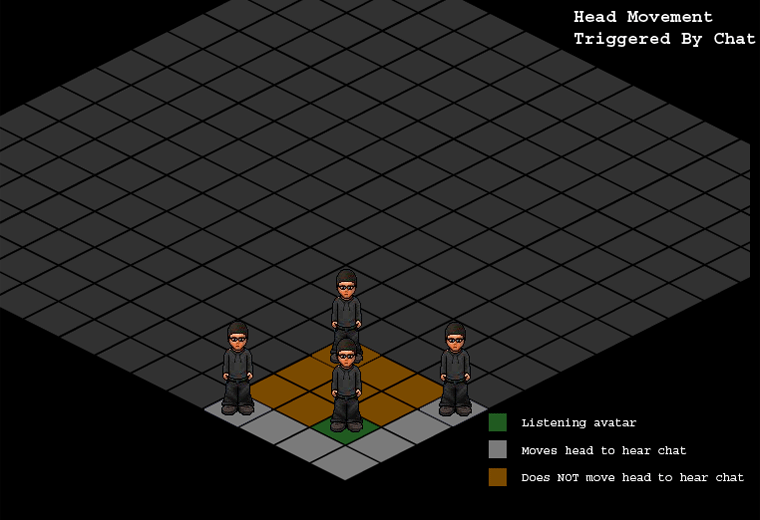
Avatar Rules
I developed some "avatar rules" to help us determine the best game and software design. This example describes the V-ego head orientation in response to chat in his immediate vicinity.
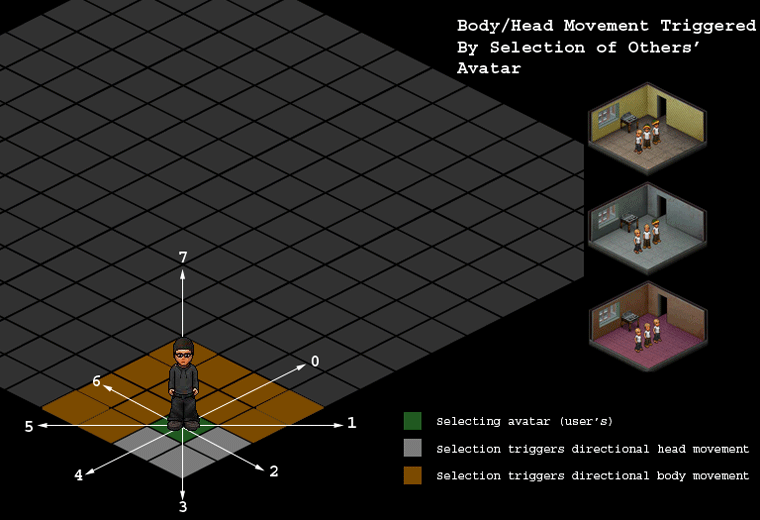
Avatar Rules
This illustration describes the V-ego body orientation in response to his owner's isometric grid selections. To navigate your V-Ego, you would click on an open tile.
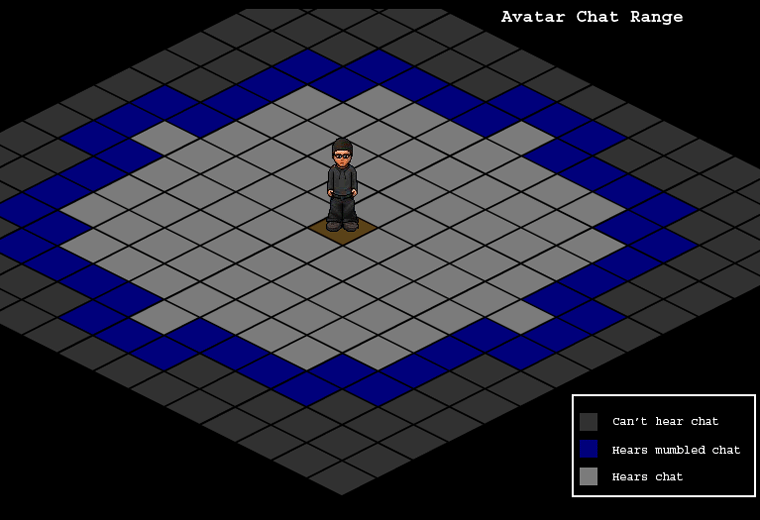
Avatar Rules
V-Egos had a wide range of hearing, but we established a boundary where they would not be able to clearly discern chat. Beyond that perimeter, chat could not be heard at all. This allowed the users to hold private conversations in key spots in a studio - a privelage cherished by the cliquish teen denizens.
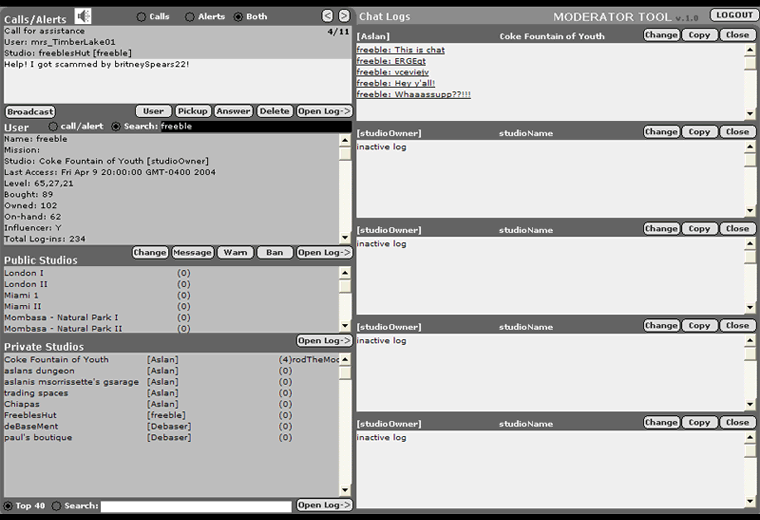
Mod Tool
I developed the Mod Tool used to help the game moderators keep order in the virtual world. Coca-Cola was serious about protecting its' investment and didn't want any malevolence or lawsuits to ruin it. Profanity, scamming, and hacking were in abundance and we fought an on-going battle to keep the virtual world up and running.
‹
›
